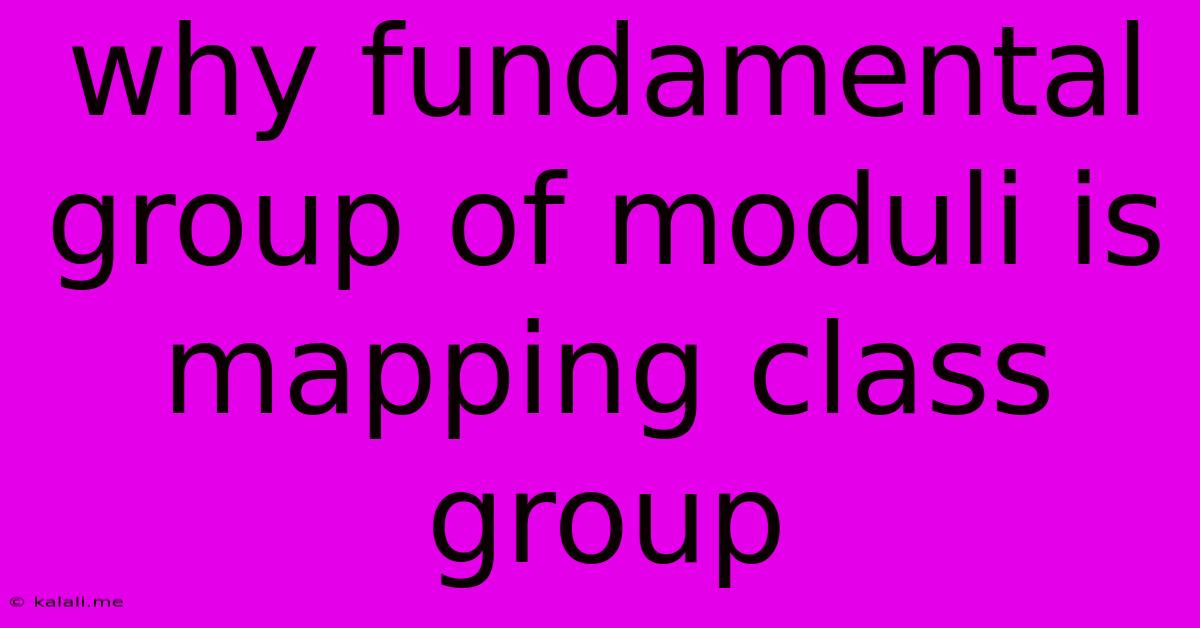Why Fundamental Group Of Moduli Is Mapping Class Group
Kalali
May 23, 2025 · 3 min read

Table of Contents
Why the Fundamental Group of Moduli Space is the Mapping Class Group
The relationship between the fundamental group of the moduli space of Riemann surfaces and the mapping class group is a cornerstone of modern algebraic topology and Teichmüller theory. This article will explore this fundamental connection, providing an intuitive understanding of why these two seemingly disparate objects are, in fact, isomorphic. Understanding this relationship unlocks deeper insights into the geometry and topology of surfaces.
The moduli space of Riemann surfaces, denoted by M_g, represents the space of all Riemann surfaces of genus g (i.e., surfaces with g "holes") modulo the equivalence relation of conformal equivalence. Intuitively, it's the "space of all possible shapes" of a surface of a given genus. The mapping class group, denoted by Mod_g, is the group of isotopy classes of orientation-preserving diffeomorphisms of a surface of genus g. In simpler terms, it's the group of all ways you can continuously deform a surface without cutting or gluing, modulo continuous deformations that can be undone.
Understanding the Connection: A Geometric Perspective
The key to understanding the isomorphism lies in recognizing how paths in the moduli space M_g correspond to diffeomorphisms of the surface. Consider a path in M_g. This path represents a continuous deformation of the Riemann surface. Each point along the path represents a specific conformal structure (shape) of the surface. This continuous deformation can be viewed as a continuous family of diffeomorphisms acting on a reference surface.
When the path forms a loop (starting and ending at the same point in M_g), it describes a closed path of deformations. This closed path corresponds to a diffeomorphism of the reference surface that is homotopic to the identity (meaning it can be continuously deformed to the identity map). However, it's not necessarily the identity map itself; it represents a sequence of deformations that return the surface to its original state. This is precisely an element of the mapping class group Mod_g.
The Formal Isomorphism
The formal proof of the isomorphism π₁(M_g) ≅ Mod_g relies on techniques from Teichmüller theory. The Teichmüller space, denoted by T_g, serves as a universal covering space for M_g. T_g is a contractible space that parametrizes marked Riemann surfaces. A "marked" surface is a surface with a choice of basis for its fundamental group. The mapping class group acts on T_g as deck transformations (covering transformations).
The fundamental group of M_g is precisely the group of deck transformations of the covering map T_g → M_g. Since the mapping class group acts as these deck transformations, this establishes the isomorphism.
Implications and Further Exploration
This fundamental theorem has far-reaching consequences:
- Understanding the topology of moduli space: The mapping class group, a well-studied algebraic object, provides crucial information about the topology of the moduli space, a complex and highly non-trivial space.
- Geometric group theory: This connection bridges the gap between the geometry of Riemann surfaces and the algebraic structure of the mapping class group, leading to deep results in geometric group theory.
- Low-dimensional topology: The study of mapping class groups is intimately linked to low-dimensional topology and the classification of surfaces.
The isomorphism between the fundamental group of the moduli space and the mapping class group is a powerful result that elegantly connects seemingly disparate fields of mathematics. It offers a profound understanding of the geometry of Riemann surfaces and the structure of their deformations, opening up avenues for further research and exploration in various branches of mathematics.
Latest Posts
Latest Posts
-
Magento 2 How To Call A Template In Block
May 23, 2025
-
Insufficient Access Rights On Cross Reference Id
May 23, 2025
-
After Getting Hit The Target Burns For 1d4 Fire
May 23, 2025
-
Any Real Posessions In Evil Series
May 23, 2025
-
Fiddler On The Roof Sabbath Prayer
May 23, 2025
Related Post
Thank you for visiting our website which covers about Why Fundamental Group Of Moduli Is Mapping Class Group . We hope the information provided has been useful to you. Feel free to contact us if you have any questions or need further assistance. See you next time and don't miss to bookmark.